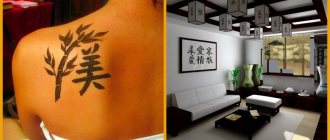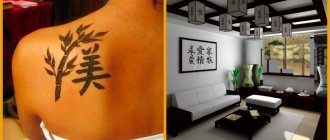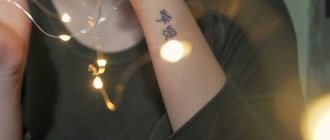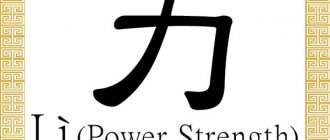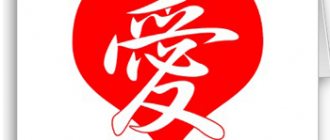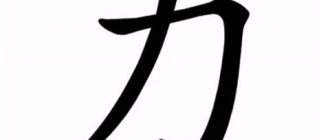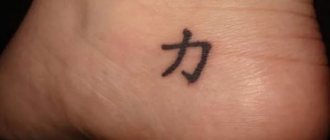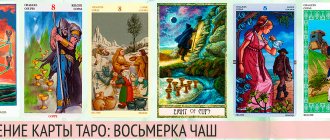If you've been learning Japanese for a long time, then it's likely that Japanese characters have become part of your everyday life and are not something outlandish. However, for a beginner or someone completely unfamiliar with Japanese writing, Japanese characters can evoke a lot of feelings, from complete misunderstanding of the meaning of these mysterious squiggles to intense curiosity.
If you see a hieroglyph, for example, as a tattoo or on someone's wall as a decoration, then it is likely that you will want to know its meaning. Well, it’s not just that a person chose this set of lines and sticks, which intricately adds up to a meaning accessible to a select few.
Eastern culture remains popular in Russia, and a large number of people strive to understand the mysterious eastern world.
For what purposes do people look for specific hieroglyphs?
Primarily for tattoos. A hieroglyph tattoo attracts the attention of others (it is likely that many people, having seen the tattoo, will want to know the meaning). A stuffed hieroglyph is an identifier of belonging to a secret for its owner, and can also tell others (if they know the meaning of the kanji) what the person with the hieroglyph pays attention to, for example, health, love or wealth, and in some cases all of this at once.
For a person of European culture, hieroglyphs carry an aura of mystery and a kind of magic. For the same reason, people buy talismans or amulets in the form of hieroglyphs and believe in their protection, trying to join Eastern wisdom.
Some people are fascinated by the magic of calligraphy . Beautiful writing of hieroglyphs is an entire art, which consists not only of using a brush competently, but also focusing your mind on the meaning of the hieroglyph, gathering all the power of the brush, drawing the treasured sign.
Another area of application of hieroglyphs is Feng Shui. This is an ancient Chinese teaching about the harmonization of space. It is believed that characters placed in the right place (for example, the Japanese character for “Wealth” in a wallet) attract what they mean. They contain deep meaning and are believed to have great power.
So, below you can get acquainted with the hieroglyphs that are in greatest demand, as well as the order in which they are written. Imagine the surprise of your friends when you can easily not only tell the meaning of a hieroglyph depicted, for example, on the hand of your interlocutor, but also read it.
Japanese character for “love”
愛(ai). Perhaps one of the most popular hieroglyphs, especially among married couples. Helps attract true feelings. Not to be confused with 恋 (koi). In the first case, we mean love not only for the opposite sex, but also for nature, life, and art. In the second case - romantic love for a specific person, even to some extent manifested in the desire to possess.
The order of strokes of the character 愛:
Where is the best place to place the symbol in the house?
The choice of location for the talisman depends on the goal pursued by the owner of the sign:
- they are placed in the bedroom (preferably closer to the sleeping area) in cases where they want to increase sexual activity or conceive a child (you can even apply the hieroglyph directly to the bed linen);
- in the northern part of the office (or at least the work area) a hieroglyph is placed if you want to achieve success in business;
- double happiness, placed on the western side of the work area, helps to find partners or sponsors and make the right acquaintances;
- to achieve financial well-being and profit, you need to put a sign in your wallet;
- A talisman is hung above the bed to achieve mutual understanding in relationships.
The amulet can be worn as a pendant or keychain. This way you can protect yourself from enemies and thieves. It is recommended to take the talisman with you on a long journey. To protect against accidents, Double Happiness is placed in the top pocket of clothing.
Japanese character for “health”
健康 (kenkou). It is the combination of two kanji that forms the word “health”. It is believed that the image of this hieroglyph helps to improve the well-being of its owner. Sometimes you can simply find the character 健, but separately it means “healthy.”
What else can you do with hieroglyphs?
In addition to tattoos, Feng Shui and talismans, Japanese characters can be used in the following cases:
- Use your favorite hieroglyph when creating a hand-made postcard. This will be a memorable gift with which you will express your feelings or wishes in an unusual way. The postcard will be especially valuable for those who are interested in martial arts.
- In addition to the postcard, a mug with a hieroglyph would be a great gift idea
- Writing on a T-shirt is much less risky than getting a tattoo. Moreover, it is much more pleasant to wear a T-shirt with an inscription, the meaning of which is close to your spirit, than to try with difficulty to find a thing with an inscription on which would suit you.
- Japanese-style interiors are very popular these days. Well, what is Japanese style without a hieroglyph? If you want to contemplate a Japanese symbol on the wall of your room, you can watch a video with calligraphy lessons and create a real masterpiece on beautiful paper or a bamboo napkin. Another option is to make a custom photo wallpaper or poster.
- For those who are fond of needlework (embroidery, beads, etc.), creating a pattern on a pillow or panel will be akin to calligraphy. The main thing is to choose a beautiful layout.
- If you are invited to a Japanese-themed party (or even a simple party), bring candy, but not plain candy. Wrap each candy with a wish in the form of a hieroglyph to the person who will receive this candy.
If you want to learn how to write the most popular Japanese characters, then remember the most important rule - kanji are always written in a strict sequence of strokes. According to one Japanese scholar, if you write a hieroglyph without following the sequence, then you are committing a violent act on it.
It is also necessary to pay special attention to the meanings of hieroglyphs, so as not to get into an awkward situation when meeting a native speaker or a person who understands hieroglyphs. It is better not to spontaneously search for the meanings of hieroglyphs on the Internet, but to contact a Japanese friend (if you have one) or an experienced Japanese scholar.
But, you see, just knowing a few hieroglyphs is not that interesting. Especially if you plan to seriously study the Japanese language, you will face many difficulties, which often become the reason for the fading of interest in learning the language. And all because many people simply do not know how to learn kanji correctly. But we have great news for you - you can learn how to effectively memorize hieroglyphs in our course “Effective techniques for memorizing hieroglyphs.” Thanks to these activities, you will be able to predict not only the sequence of features even in hieroglyphs that are unfamiliar to you, but also the meaning and even the reading! There are not very many places in the group, so hurry up before all the basics are covered without you! You can find out more and purchase the course here.
Hieroglyphs were and remain to this day a beautiful and fascinating type of writing that can be mastered and improved endlessly.
Want to learn more about hieroglyphs?
Then sign up for a free course on effectively learning Japanese characters
Did you manage to write down the hieroglyphs given above? Please share in the comments.
Writing and meaning of symbols
Chinese is the most difficult language in the world. Each character represents a unique pattern and has its own history, meaning and recording characteristics. They are associated with the traditions and customs of modern Chinese. One character can mean a whole word or one syllable; many words contain two syllables. The main rule of writing is to draw from left to right and from top to bottom, without raising your hand.
When learning a language, people try to think of associations with signs in order to remember them better. In total, there are about 200 graphic designs that make up the hieroglyphs. Each of them in itself has no meaning. Only when they are connected in a certain sequence do they create a character.
Basic characters for writing:
- vertical line;
- horizontal line;
- dot;
- broken line;
- turn right or left;
- Up dash;
- hook.
Many characters are so similar to each other that they differ only by a small line. And sometimes an extra dash changes the meaning of a symbol to the opposite.
Chinese sages say that a hieroglyph is life; new ones are periodically “born” and old ones die off.
Happiness
Human happiness is a very multi-dimensional concept and it varies from person to person. The Chinese character for happiness (Fu) consists of two parts: god and abundance. This is the source of fulfillment of everything that is necessary for true happiness. This symbol calls upon the powers of the Gods and Heavens to help you achieve success and find happiness. To receive more prosperity from the ocean of abundance of the universe, place the symbol in the southeast, if love, then in the southwest.
When entering a house, it is customary to hang an inverted symbol of happiness. The visitor sees this and thinks: “The hieroglyph for ‘happiness’ is upside down,” which corresponds to the phrase “Happiness has arrived.”
Presenting the hieroglyph “happiness” is the best wishes to your loved ones.
The “happiness” sign was one of the first to appear and was used in rituals in honor of the gods. Now it is a universal symbol that has many meanings: joy, pleasure. The left part represents the sacrificial altar, and the right part reflects the components of well-being: the roof, the person, the field.
Happiness is God's blessing on a person, his ability to have a home and livelihood for his family.
Double Happiness
The picture consists of two identical halves, which, placed side by side, are full partners in each area. This powerful symbol brings fulfillment of all innermost desires, harmony in marriage and a happy family life. In China, this sign hangs on the door of the room where newlyweds sleep, for their happiness in love. Double happiness means happiness for each person in the couple. The symbol on the gift doubles whatever the giver sincerely desires.
There is a tradition of placing a symbol of double happiness under the bed of a young couple trying to conceive and above the bed to enhance their feelings. If placed in the office, it will help attract like-minded partners to improve the business. Those who want to find love should wear this symbol as an amulet.
A gift with a symbol of double happiness can be a sign of your willingness to share happiness with a person. If you cut this figurine out of red paper and decorate it with images of birds and flowers, it will bring not only good luck, but also abundance.
The position of the “double happiness” symbol can be any.
Luck
The Chinese character “Luck” (ji) will become a real amulet for attracting and maintaining good luck in any endeavor. It is better to keep it at home so as not to let go of the “bird of happiness”. This character is the most powerful and can be used to achieve success in any industry.
Visually, it consists of two parts: the upper one is translated as “sage”, and the lower one is translated as “mouth”. The ancient Chinese believed that the orders of the sages were the direct path to happiness and prosperity, so they listened to them. The Chinese character for "happiness" means "a word spoken by a wise person."
Despite its widespread use, it is not recommended to carry this symbol in a purse or on a pendant. He must definitely “get in touch” with the house, which needs happiness and good luck.
Wealth
This symbol creates positive chi energy in the home or business premises. It helps to increase wealth, not only material, but also spiritual, helps create an atmosphere of well-being, facilitates cash flow, and removes all obstacles to success.
To attract wealth and increase income, the Chinese suggest storing an image or photo of this symbol in money matters: in piggy banks, safes, wallets, or hanging in the southeast corner of the room. Savings are often kept in red envelopes or wallets labeled “Wealth.”
It is traditionally given to friends because the Chinese believe in the boomerang principle: anything given with a pure heart will always come back.
Love
The sign of “love” is a talisman that can protect the feelings of light in marriage and family happiness. With its help, conflicts are extinguished before they can flare up, and harmony reigns in the house. Feng Shui considers this sign to be very powerful, as it not only helps to find a soul mate, but also strengthens existing relationships. To achieve the effect, you should place a symbol of “love” in your home, preferably in the southwest, and wear it close to your heart in the form of a pendant or talisman.
Wellbeing
In Chinese it is "ping'an". This important symbol can be placed on the wall of your house to make you lucky to notice that particular house. In China, it is customary to decorate the front door during Chinese New Year. It is said that the goddess of poverty does not come to the house where she is used as a sign of good health and longevity.
Why are hieroglyphs used in Feng Shui?
hieroglyphs on a coin
In Feng Shui, hieroglyphs can be used as independent talismans (place the image of the hieroglyph in the desired part of the house), or they can be amplifiers of an existing talisman (for example, depicted on Feng Shui coins, red envelopes, on a Feng Shui pagoda and etc).
The hieroglyphs that you write yourself will work great. The correct way to write them is from top to bottom and left to right. As you do this, think about your intention or desire. In this case, the hieroglyphs will have double power and will allow the plan to come true faster.
If you are good at drawing, you can simply copy the image of a hieroglyph. Well, if you don’t have the talent of an artist, you can use your ingenuity and do it as follows.
hieroglyph "Wealth"
To make sure I don’t make a mistake, because the correct spelling of a Feng Shui hieroglyph is very important, for example, I did this: I printed out an image of the desired hieroglyph from the Internet. She placed a blank sheet of paper on top and placed these two pieces of paper against the window (so that the printed hieroglyph would show through and you could see it through the blank sheet).
And then I traced the hieroglyph on a blank sheet of paper from top to bottom, from left to right. Since the hieroglyph that I “wrote myself” means “love,” in order to enhance its effect, I painted it red (the color of love and passion in Feng Shui). Look what I came up with (in the picture)
